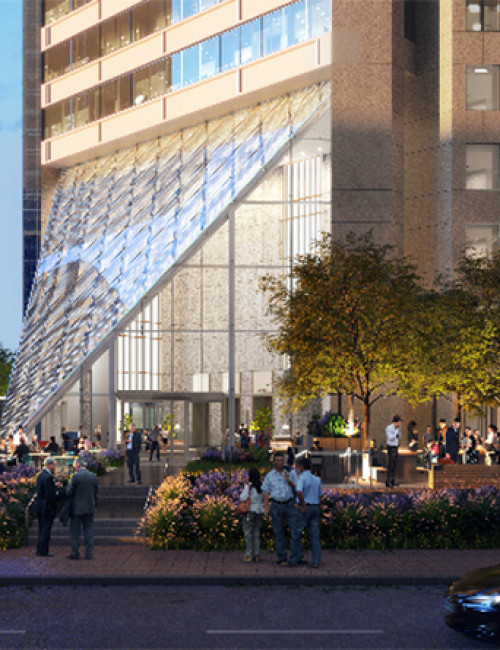Height rank
JPMorgan Chase Tower
Houston
- CTBUH Drawing
- Facts
-
Metrics
You must be a CTBUH Member to view this resource.
To Tip:
Height is measured from the level of the lowest, significant, open-air, pedestrian entrance to the highest point of the building, irrespective of material or function of the highest element (i.e., including antennae, flagpoles, signage and other functional-technical equipment).Architectural:
Height is measured from the level of the lowest, significant, open-air, pedestrian entrance to the architectural top of the building, including spires, but not including antennae, signage, flag poles or other functional-technical equipment. This measurement is the most widely utilized and is employed to define the Council on Tall Buildings and Urban Habitat (CTBUH) rankings of the "World's Tallest Buildings."Occupied:
Height is measured from the level of the lowest, significant, open-air, pedestrian entrance to the highest occupied floor within the building.
Above Ground
The number of floors above ground should include the ground floor level and be the number of main floors above ground, including any significant mezzanine floors and major mechanical plant floors. Mechanical mezzanines should not be included if they have a significantly smaller floor area than the major floors below. Similarly, mechanical penthouses or plant rooms protruding above the general roof area should not be counted. Note: CTBUH floor counts may differ from published accounts, as it is common in some regions of the world for certain floor levels not to be included (e.g., the level 4, 14, 24, etc. in Hong Kong).Below Ground
The number of floors below ground should include all major floors located below the ground floor level.Official Name
JPMorgan Chase Tower
Other Names
Chase Tower, Texas Commerce Tower
Type
Building
Status
Completed
Completion
1982
Country
City
Address
Function
A mixed-use tall building contains two or more functions (or uses), where each of the functions occupy a significant proportion of the tower's total space. Support areas such as car parks and mechanical plant space do not constitute mixed-use functions. Functions are denoted on CTBUH "Tallest Building" lists in descending order, e.g., "hotel/office" indicates hotel function above office function.
Office
Structural Material
Both the main vertical/lateral structural elements and the floor spanning systems are constructed from steel. Note that a building of steel construction with a floor system of concrete planks or concrete slab on top of steel beams is still considered an “all-steel” structure as the concrete elements are not acting as the primary structure.
All-Concrete
Both the main vertical/lateral structural elements and the floor spanning systems are constructed from concrete which has been cast in place and utilizes steel reinforcement bars and/or steel reinforced concrete which has been precast as individual components and assembled together on-site.
All-Timber
Both the main vertical/lateral structural elements and the floor spanning systems are constructed from timber. An all-timber structure may include the use of localized non-timber connections between timber elements. Note that a building of timber construction with a floor system of concrete planks or concrete slab on top of timber beams is still considered an “all-timber” structure as the concrete elements are not acting as the primary structure.
Mixed-Structure
Utilizes distinct systems (e.g. all-steel, all-concrete, all-timber), one on top of the other. For example, a Steel Over Concrete indicates an all-steel structural system located on top of an all-concrete structural system, with the opposite true of Concrete Over Steel.
Composite
A combination of materials (e.g. steel, concrete, timber) are used together in the main structural elements. Examples include buildings which utilize: steel columns with a floor system of reinforced concrete beams; a steel frame system with a concrete core; concrete-encased steel columns; concrete-filled steel tubes; etc. Where known, the CTBUH database breaks out the materials used within a composite building’s primary structural elements.
Concrete-Steel Composite
Energy Label
LEED Gold
Official Website
Height
305.4 m / 1,002 ft
Floors Above Ground
75
Floors Below Ground
4
# of Parking Spaces
192
# of Elevators
52
Top Elevator Speed
7.1 m/s
Tower GFA
156,437 m² / 1,683,874 ft²
Rankings
-
By function
You must be a CTBUH Member to view this resource.
-
By material
You must be a CTBUH Member to view this resource.
Construction Schedule
Proposed
Construction Start
Completed
Retrofit Start
Owner
Developer
Architect
Usually involved in the front end design, with a "typical" condition being that of a leadership role through either Schematic Design or Design Development, and then a monitoring role through the CD and CA phases.
Contractor
The main contractor is the supervisory contractor of all construction work on a project, management of sub-contractors and vendors, etc. May be referred to as "Construction Manager," however, for consistency CTBUH uses the term "Main Contractor" exclusively.
Other Consultant
Other Consultant refers to other organizations which provided significant consultation services for a building project (e.g. wind consultants, environmental consultants, fire and life safety consultants, etc).
Other Consultant refers to other organizations which provided significant consultation services for a building project (e.g. wind consultants, environmental consultants, fire and life safety consultants, etc).
Retrofit Companies Involved
Developer
Architect
Usually involved in the front end design, with a "typical" condition being that of a leadership role through either Schematic Design or Design Development, and then a monitoring role through the CD and CA phases.
You must be a CTBUH Member to view this resource.
Owner
Cerberus Capital Management LP; Hines
Prime Asset Management; Texas Tower Ltd.
Developer
Architect
Usually involved in the front end design, with a "typical" condition being that of a leadership role through either Schematic Design or Design Development, and then a monitoring role through the CD and CA phases.
Usually takes on the balance of the architectural effort not executed by the "Design Architect," typically responsible for the construction documents, conforming to local codes, etc. May often be referred to as "Executive," "Associate," or "Local" Architect, however, for consistency CTBUH uses the term "Architect of Record" exclusively.
3D/International
Structural Engineer
The Design Engineer is usually involved in the front end design, typically taking the leadership role in the Schematic Design and Design Development, and then a monitoring role through the CD and CA phases.
CBM Engineers
MEP Engineer
The Design Engineer is usually involved in the front end design, typically taking the leadership role in the Schematic Design and Design Development, and then a monitoring role through the CD and CA phases.
I.A. Naman + Associates, Inc.
Contractor
The main contractor is the supervisory contractor of all construction work on a project, management of sub-contractors and vendors, etc. May be referred to as "Construction Manager," however, for consistency CTBUH uses the term "Main Contractor" exclusively.
Other Consultant
Other Consultant refers to other organizations which provided significant consultation services for a building project (e.g. wind consultants, environmental consultants, fire and life safety consultants, etc).
Other Consultant refers to other organizations which provided significant consultation services for a building project (e.g. wind consultants, environmental consultants, fire and life safety consultants, etc).
Cushman & Wakefield
Retrofit Companies Involved
Developer
Architect
Usually involved in the front end design, with a "typical" condition being that of a leadership role through either Schematic Design or Design Development, and then a monitoring role through the CD and CA phases.
Global News

23 July 2020
Renovations Revealed for Houston Tower, Along With Major Deal
Hines, the international real estate firm, and an affiliate of Cerberus Capital Management, L.P. (Cerberus), a global leader in alternative investing, announced on 13 July...
About JPMorgan Chase Tower
When completed in 1981, JPMorgan Chase Tower was not only the tallest building in Houston, but also the tallest granite-clad building in the world, the tallest concrete and steel composite structure and the eighth tallest building in the United States. Originally planned for 80 stores tall, the tower was shortened at the order of the Federal Aviation Administration who declared anything taller than 75 floors for this tower or any other in downtown Houston would be a hazard to air navigation.
JPMorgan Chase Tower is set onto a full block within downtown Houston’s recliner streetgrid, with two sides of the tower positioned along the sidewalks of the neighboring streets with a windowless chamfered corner at the easternmost end of the building. The tower then rises upward from the sidewalks to its full height without the use of any setbacks or articulations of the façade. The western edge of the tower features a much larger chamfered corner, creating a six sided floorplate shape, five sides of which have exterior windows. In contrast to gray granite cladding on the remainder of the tower exterior, the western façade was given a different façade treatment of stainless steel spandrels positioned between long rows of ribbon windows taking advantage of a column-free 85 foot long span. The western façade’s glazing was installed as a butt jointed glass system without large mullions between the glass panes, offering expansive views towards Houston’s west side. The remainder of the block beside the chamfered western edge of the tower is devoted to a large outdoor public plaza.
The tower’s design had introduced the concept of sky lobbies to Houston, one of which at the 60th floor serves as a public observatory, a design feature which at the time had only existed in buildings located in New York and Chicago. Below grade, JPMorgan Chase Tower is built into the subterranean pedestrian concourse network linking many nearby towers throughout downtown Houston, making it an integral part of the local neighborhood.
Global News

23 July 2020
Renovations Revealed for Houston Tower, Along With Major Deal
Hines, the international real estate firm, and an affiliate of Cerberus Capital Management, L.P. (Cerberus), a global leader in alternative investing, announced on 13 July...

26 June 2019
Two Downtown Houston Skyscrapers to be Sold for US$627 Million
The downtown Houston skyscraper commonly called JPMorgan Chase Tower, located at 600 Travis St., and the adjacent Chase Center building are reportedly being sold in...
Subscribe below to receive periodic updates from CTBUH on the latest Tall Building and Urban news and CTBUH initiatives, including our monthly newsletter. Fields with a red asterisk (*) next to them are required.
View our privacy policy















